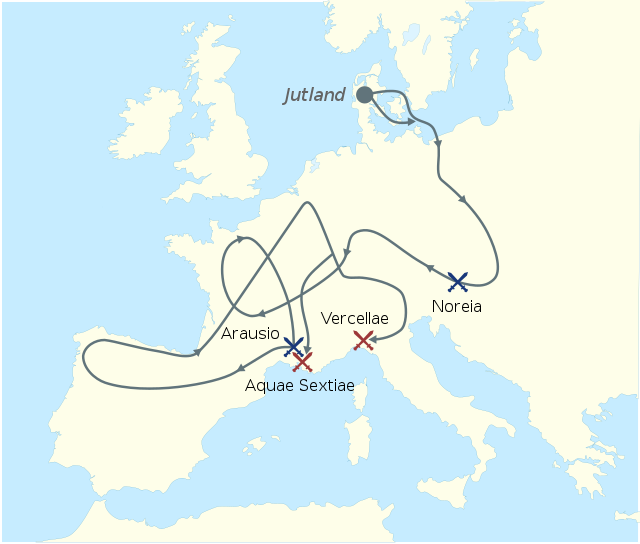Teutobod
2nd-century BC Teutonic king From Wikipedia, the free encyclopedia
Teutobod was a king of the Teutons, who, together with the allied Cimbri, invaded the Roman Republic in the Cimbrian War and won a spectacular victory at the Battle of Arausio in 105 BC. He was later captured at the Battle of Aquae Sextiae in 102 BC.[1] In legend, he was known as Teutobochus or Theutobochus,[2] a giant and king of the Teutons. Large bones discovered in France in 1613 were claimed to be his skeleton.[3]

 Cimbri and Teutons defeats.
Cimbri and Teutons defeats. Cimbri and Teutons victories.
Cimbri and Teutons victories.Life
Summarize
Perspective
In the late 2nd century BC, together with their neighbors, allies, and possible relatives, the Cimbri, the Teutons attacked south into the Danube valley, southern Gaul and northern Italy. Here they began to intrude upon the lands of Rome (Julius Caesar, in his Gallic Wars account De Bello Gallico, reports that it was the Boii who had attacked Noricum). The inevitable conflict which followed is called the Cimbrian War. The Cimbri (under their King Boiorix) and the Teutons, won the opening battles of this war, defeating tribes allied with the Romans and destroying a huge Roman army at the Battle of Arausio in 105 BC. But Rome regrouped and reorganized under Consul Gaius Marius. In 104 BC the Cimbri left the Rhône valley to raid Spain, while the Teutons remained in Gaul, still strong but not powerful enough to march on Rome on their own. This gave Marius time to build a new army and in 102 BC he moved against the Teutons. At the Battle of Aquae Sextiae the Teutons were virtually annihilated and Teutobod along with, reportedly, 20,000 of his people, were captured. After this, he and his tribe drop out of history. He most likely was sent to Rome for a triumphal procession to celebrate his defeat, then ritually executed afterward. The following year, the Cimbri would suffer a similar fate at the Battle of Vercellae, where two of their leaders, Caesorix and Claodicus, were captured, while two other leaders, Boiorix and Lugius, were killed.[4]
Teutobochus tomb
Summarize
Perspective
In 1869 W.A. Seaver wrote: "In times more modern (1613), some masons digging near the ruins of a castle in Dauphiné, in a field which by tradition had long been called 'The Giant's Field,' at a depth of 18 feet discovered a brick tomb 30 feet long, 12 feet wide, and 8 feet high, on which was a gray stone with the words 'Theutobochus Rex' cut thereon. When the tomb was opened they found a human skeleton entire, 30-1/2 feet long, 10 feet wide across the shoulders, and 5 feet deep from the breast to the back. His teeth were about the size of an ox's foot, and his shin-bone measured 4 feet in length."[5]
The bones were displayed in Paris by Pierre Mazurier, a surgeon who claimed to be one of the finders.[6]
After the finding of the bones, the legend of the king Teutobochus, which was thought to be Teutobod, spread despite analysis by anatomist Jean Riolan the Younger, who ascribed the bones to one of Hannibal's elephants. The French scholar Peiresc also demonstrated that such bones belong to elephants.[2] Theutobochus mentioned by Robert Plot in his Natural history of Oxfordshire, 1677, along with other purported giant skeletons.[7]
Much later, the zoologist Henri Marie Ducrotay de Blainville analyzed the bones and concluded they came from a mastodon. Finally in 1984, the paleontologist Léonard Ginsburg analyzed a plaster mold from the Paris Muséum national d'histoire naturelle, that came from the giant bones, and identified a Deinotherium.[8] The bones are housed in the Gallery of Paleontology and Comparative Anatomy.[9]
See also
References
Wikiwand - on
Seamless Wikipedia browsing. On steroids.
